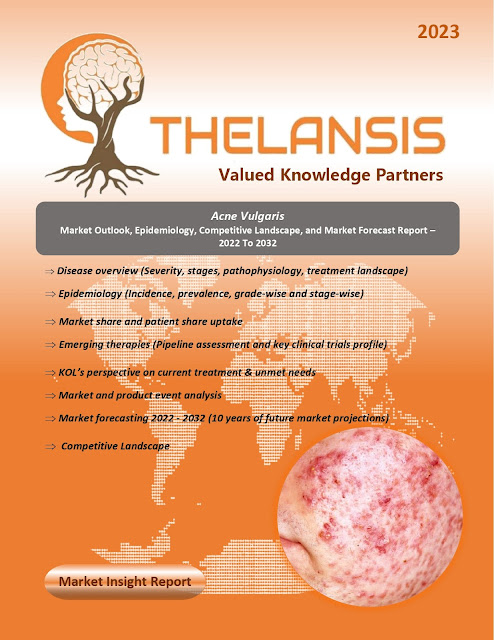Castleman Disease – Market Outlook, Epidemiology, Competitive Landscape, and Market Forecast Report – 2023 To 2033
Castleman Disease (CD) encompasses a cluster of infrequent lymphoproliferative conditions involving enlarged lymph nodes displaying distinctive microscopic alterations, an extensive array of inflammatory indications, and laboratory irregularities. It can affect lymph nodes across various bodily regions, simulating non-cancerous and cancerous anomalies, such as those found in the neck, chest, abdomen, and pelvis. From a pathological standpoint, it can be categorized into hyaline vascular type (HV-CD), plasma cell type, mixed type, and Castleman disease associated with human herpesvirus (HHV)-8. On a pathogenic level, the plasma cell variant of Castleman Disease is associated with excess production of IL-6 and heightened expression of IL-6 receptors, triggering the proliferation of B lymphocytes and vasculogenesis, which in turn results in an array of systemic manifestations like fever, anemia, hypoproteinemia, and proteinuria. In some instances of mixed CD, an elevated IL-6 level is also found to promote the generation of hepcidin from the liver, potentially leading to iron-deficiency anemia. There are four primary types of Castleman Disease: unicentric Castleman disease (UCD), localized and possibly affecting one or more enlarged lymph nodes in a specific body region; human herpesvirus 8 associated multicentric Castleman disease (HHV-8-associated MCD); POEMS-associated MCD; and idiopathic multicentric Castleman disease (iMCD), which is widespread and impacts numerous lymph nodes and lymphatic tissues. The idiopathic multicentric Castleman disease (iMCD) can be further categorized into three clinical subgroups:
- iMCD with TAFRO syndrome (iMCD-TAFRO), characterized by Thrombocytopenia, Anasarca, Fever, Renal dysfunction, or Reticulin fibrosis and Organomegaly.
- iMCD with idiopathic plasmacytic lymphadenopathy (iMCD-IPL), identified by thrombocytosis, hypergammaglobulinemia, and a more protracted disease trajectory.
- iMCD, not otherwise specified (iMCD-NOS), diagnosed in iMCD patients devoid of TAFRO syndrome or iMCD-IPL.
Unicentric Castleman Disease demonstrates a highly favorable prognosis. It typically does not advance into lymphoma, and surgical excision of the tumor results in a cure for 90–95% of cases. The prognosis for individuals with Multicentric Castleman Disease varies, contingent upon the precise nature of their ailment. Some patients encounter severe exacerbations that can be life-threatening, whereas others endure more lingering symptoms.
- The historical 5-year overall survival rate has hovered around 65-75%. Around 4,300-5,200 fresh cases of Castleman Disease are diagnosed annually in the United States. Unicentric Castleman disease is more prevalent than multicentric Castleman disease and can manifest in individuals of any age, gender, or ethnicity, affecting both children and adults. It is most frequently observed in younger females.
Thelansis’s “Castleman Disease Market Outlook, Epidemiology, Competitive Landscape, and Market Forecast Report – 2023 To 2033" covers disease overview, epidemiology, drug utilization, prescription share analysis, competitive landscape, clinical practice, regulatory landscape, patient share, market uptake, market forecast, and key market insights under the potential Castleman Disease treatment modalities options for eight major markets (USA, Germany, France, Italy, Spain, UK, Japan, and China).
KOLs insights of Castleman Disease across 8 MM market from the centre of Excellence/ Public/ Private hospitals participated in the study. Insights around current treatment landscape, epidemiology, clinical characteristics, future treatment paradigm, and Unmet needs.
Castleman Disease Market Forecast Patient Based Forecast Model (MS. Excel Based Automated Dashboard), which Data Inputs with sourcing, Market Event, and Product Event, Country specific Forecast Model, Market uptake and patient share uptake, Attribute Analysis, Analog Analysis, Disease burden, and pricing scenario, Summary, and Insights.
Thelansis Competitive Intelligence (CI) practice has been established based on a deep understanding of the pharma/biotech business environment to provide an optimized support system to all levels of the decision-making process. It enables business leaders in forward-thinking and proactive decision-making. Thelansis supports scientific and commercial teams in seamless CI support by creating an AI/ ML-based technology-driven platform that manages the data flow from primary and secondary sources.




Comments
Post a Comment